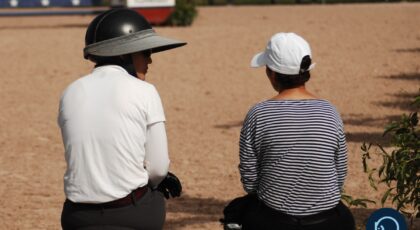Young horses demand certain types of nutrition and veterinary care that are a little different from adult equine needs.
My young Warmblood True has been very healthy. I attribute that partly to a sturdy constitution, but also to regular attention from his excellent veterinarian and farrier, supplements that build a youngster’s body, and techniques for problem prevention.
Constitution—When buying a young horse (or any horse, for that matter), have a licensed veterinarian do a pre-purchase exam. You’ll earn the cost back a hundred times over by starting with a healthy animal.
Choose a veterinarian who has never examined or treated this horse in the past. You want an independent opinion of the horse’s health. If the horse is not local, be sure the examining veterinarian speaks with your local vet to address any concerns.
True’s pre-purchase exam came back with an A+. He was sturdy, strong, well developed for his age, and all his body systems (cardio, respiratory, neurological, skeletal, etc.) were in excellent condition. The examining veterinarian sent radiographs of all four legs to my local veterinarian, and both agreed there were no problems, no suspicions, no reasons for concern.
Other horses I almost bought at that time were not so lucky.
Veterinary attention—Within a week of arrival, True was vaccinated against the diseases that are local to my area. Necessary vaccines for a horse in New York are not the same as necessary vaccines for Arizona, for example.
At the same time, your veterinarian should check your new horse’s teeth, float them if necessary, inspect a fecal sample for worm eggs, and deworm as needed. Develop a deworming plan for the new horse with your veterinarian’s help. After the initial appointment, your horse should be vaccinated, examined for dental problems, and inspected for worms every spring and fall.
Farrier attention—True is barefoot, not because of any great philosophy of naturalism on my part, but because he has big round dinnerplate feet; super-strong in wall, frog, and sole; and is usually ridden in sand arenas. He does not need shoes.
But many horses do, so work with a certified farrier to be sure your horse gets whatever her individual feet require. This, too, should be addressed within the the first week or two of your young horse’s arrival.
And remember, bare feet still need attention: True’s are trimmed every six weeks.
Supplements—I usually rely on excellent quality grass or alfalfa hay for feeding and prefer to avoid additional supplements. However, a young horse is still growing, and her skeleton and muscles need more protein than they will when she is mature. Ask your veterinarian to recommend a good high-protein supplement or ration balancer.
What’s the difference? The straight supplement will also add weight to the horse—wonderful if your baby is thin. The ration balancer adds protein but is relatively low in calories, so it works well for the chubby baby.
If you board your horse, be aware that supplement mistakes are among the most common at boarding stables. Reduce the risk by reducing or simplifying the task.
For example, if your horse requires multiple supplements, mix them yourself and place each day’s ration in an individual container. It’s safer for your horse, and barn staff will appreciate your efforts to make their job easier.
Prevention—Stick to your feeding, veterinary, and farrier routine. Horses need regular care, not “only-when-injured” care. Be sure your horse is in proper condition, not too fat, not too thin, shiny coat, bright eyes, energetic. Examine his body while grooming daily to see if anything unusual has popped up.
Inspect your horse’s stall, paddock, or pasture once a month or so, looking for loose fencing, straggling wires, or sharp metal edges. When you find something, get it fixed immediately.
Colic is the number one cause of death in horses, so lock your feed room, make all feed changes slow and gradual, watch for signs of colic, and address them immediately. Laminitis is a common cause of lameness when horses are fed rich supplements or natural grass. In some areas of the world, grass is very rich and needs to be offered in small amounts.
When working your horse, prevent exercise problems by warming up and cooling down at a walk for at least 10 minutes each. Think about how hard the horse is working—is it hot outside? Cold? Is the horse sweating a lot? What’s the elevation—is she getting enough oxygen? Do you have to push this horse to work harder or faster? And so on.
Give your horse short rest breaks during her training session, three or four minutes here and there. It helps her body, but if you time breaks properly, they also reinforce positive lessons in her mind. After a workout, cold-hose or ice-wrap your horse’s legs for 10 minutes to prevent soreness or swelling. When spring comes and you’re all hyped up for the new show season, build the horse’s workload slowly and gradually.
True hasn’t had any health problems, though he has had a facial cut that needed six sutures. It was caused by a pointed screw end that had not been cut off, located behind a support board near his feeder in an area that most people would swear a horse could never reach. I’m very grateful it wasn’t worse.
All of the tips here help, but a dose of good luck is sometimes necessary, too. Horses are a lot more fragile than their size would suggest. Take good care of yours!
Related reading:
Janet Jones will present “Brain to Brain: Cross-Species Communication between Horses and Riders” at the World Equestrian Center in Ocala, Florida, on March 14, 2024. Come to the talk and enjoy the international Winter Spectacular Hunter/Jumper Horse Show too. Learn more and reserve your tickets at https://janet-jones.com/product/janet-jones-ticket-sales.

A version of this story originally appeared on janet-jones.com. It is reprinted here with permission.


 February 22, 2024
February 22, 2024 

























